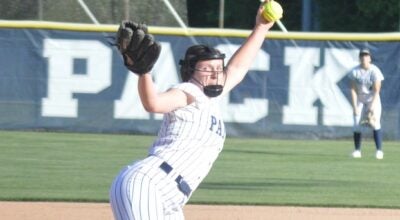Cold weather brings ducks to coast
Published 11:05 pm Tuesday, December 3, 2013
North Carolina duck hunters always pray for an early onslaught of cold weather in states to our north because many of the ducks don’t leave these areas until the water begins to ice-over and forces the waterfowl to continue their southerly migration. It takes some really cold weather to bring the diving ducks into our area and the weather we’ve seen this past week should give the bluebills, canvasbacks, widgeons, buffleheads and pintails good reasons to visit our state.
Waterfowl hunters in the Pamlico Sound area have reported some limit kills of sea ducks, divers such as scaup, ruddys and buffleheads and an occasional puddle duck such as pintails thrown for good measure.
I haven’t heard of any canvasbacks showing up in our waters yet but this cold weather should bring them down in what the forecasters are calling a “good” year for these big ducks. The daily bag limit of cans is two per day this year.
The daily limit of other ducks reflects optimism on the part of the waterfowl biologists too. These conventional bag limits are 6 ducks with no more than 4 scoters, 4 mallards with no more than 2 hen mallards, 3 wood ducks, 2 scaup, 2 redheads, 2 pintails, 1 black or mottled duck (season closed until November 23), or 1 fulvous whistling duck. The season on harlequin ducks is closed.
As usual the waterfowl hunters are being made aware of the state and federal regulations on hunting waterfowl with the aid of bait. It’s been many years ago that the federal wardens nicknamed our Tar Heel waterfowl hunting grounds as the “Gold Coast of the Atlantic flyway” because of all the shelled corn that some hunters dumped overboard to attract more ducks.
The North Carolina Wildlife Resources Commission’s website states that “Baiting as it applies to waterfowl hunting is a controversial and often misunderstood subject. Therefore, it is incumbent upon every waterfowl hunter to understand all baiting laws, both state and federal, as they pertain to waterfowl hunting.
“Birds by the aid of baiting (placing feed such as corn, wheat, salt or other feed to constitute a lure or enticement), or on or over any baited areas. Hunters should be aware that a baited area is considered to be baited for 10 days after the removal of the bait.
“Although state law prohibits take of migratory game birds within 300 yards of a baited area, federal law prohibits take on or over any baited area which could serve as a lure or attraction. This “zone of influence” may extend a much greater distance. Substantial penalties for violations apply. For questions, contact the U.S. Fish and Wildlife Service, Resident in Charge in Raleigh, N.C. at (919) 856-4786.
“Hunters should refer to the current North Carolina Inland Fishing, Hunting and Trapping Regulations Digest for additional information regarding baiting and waterfowl hunting.”
Years ago I accompanied USFWS biologists on their winter inventory flight over the Pamlico Sound and the yellow corn in the shallows of the sound shone like gold underwater. “The Gold Coast of the Atlantic Flyway” was a good nickname in those days. With both state and federal regulations a bit changed over the years we don’t see quite as much baiting as we used to see but a few still depend on their “yellow decoys” to help insure a bag limit of ducks and geese.
It used to be that the federal regulations on waterfowl baiting depended on the concept of “Strict liability” when it came to issuing citations to waterfowl hunters charged with hunting over (or with) the aid of bait. The strict liability of the federal regulation meant that a hunter charged with a baiting violation was guilty until proven innocent (as opposed to innocent until proven innocent under conventional laws). That regulation was modified after oversight hearings were held in Congress years ago and now clearly state that waterfowl hunters were not to be charged unless they knew or should have known that bait was present,
A contingent of concerned North Carolina duck hunters met with the then Governor of North Carolina, James Martin about the problem of many hunters who were clearly innocent of the baiting violations being wrongly convicted under the State of North Carolina Wildlife laws. Those regulations were also modified to mirror the federal baiting regulations. Waterfowl hunters should still be very careful that they don’t blunder into a baited area and not realize that they’re violating both state and federal laws. It a hunter makes a “reasonable effort” to determine that there’s no bait there and finds the area void of bait, then he shouldn’t be charged with a violation.
Many waterfront property owners still feed the visiting waterfowl shelled corn (or other forms of bait) in front of their homes and, as long as they don’t shoot over (or with the aid of) that food source, then it’s perfectly legal to do so. These bird watchers have a perfect right to feed these birds and enjoy photographing and observing the ducks and geese. Often these areas are well marked warning hunters that they’d be breaking the law to hunt there. It would be wise for hunters to be careful not to blunder into these areas
Two waterfowl hunting seasons ago many of us along the Pamlico River and Sound witnessed what we “Old Timers” feel was the greatest concentration of bluebills (scaup ducks) that the area had ever hosted. Biologists feel that this huge concentration was due to Hurricane Irene’s uncovering large numbers of Carolina clams that the ducks liked to feed on. We haven’t seen the likes of H. Irene before or after that disaster but the hurricane did have some welcome effects on the waterfowl that year.






